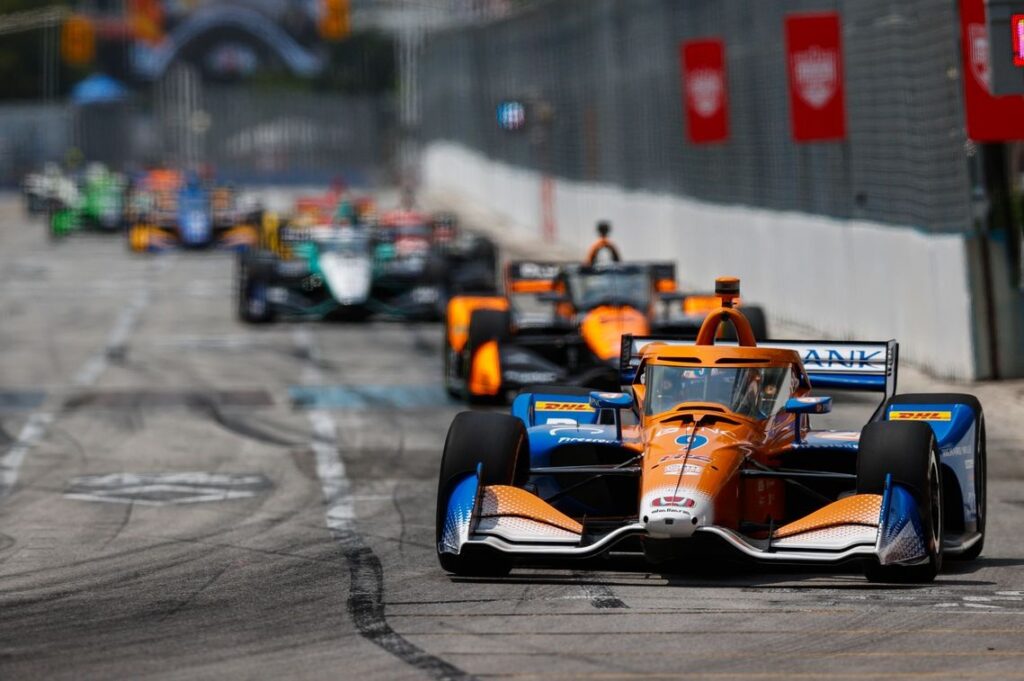Scott Dixon once again proved why he remains the master of IndyCar Series strategy by charging from 15th on the grid to the podium at Toronto on Sunday.
The 44-year-old Chip Ganassi Racing ace bounced back from a poor qualifying performance, for which he shouldered the blame, by passing 12 cars en route to third place.
Dixon was already up to sixth after overcutting several rivals in the first round of pitstops, stopping 12 laps later than team-mate Alex Palou – who had also started out of position due to a penalty in qualifying.
Dixon overcut again during the final pit cycle, after a rapid stint on the softer alternate tires, to grab third place.
That meant unlike Palou, who went from 18th to fourth using an undercut strategy, he didn’t benefit from any of the late wrecks that removed fellow title challengers Will Power, Scott McLaughlin and Pato O’Ward from the top 10.
“The car had a ton of speed,” said Dixon. “Maybe (passed) three or four cars at the start, then started picking them off.
“Once we got clean air, we could run (a) really fast pace. Just started overcutting everybody.
“I guess in theory we needed a bit of a longer race, maybe a 120-lap race would have been great! The overcut worked well.”
Toronto IndyCar pitstop strategies
Driver
1st stop
2nd stop
Herta/Kirkwood
35
54
Dixon
37
55
Palou
25
50
Armstrong
21
53
Power
26
52
McLaughlin/O’Ward
18
51
Scott Dixon, Chip Ganassi Racing Honda
Photo by: Jake Galstad / Motorsport Images
When asked to elaborate on why he’d chosen that strategy from a mid-pack starting spot, Dixon explained that the overcut only truly worked if you could unleash fast pace in clear air. His fastest lap was almost three tenths quicker than Palou’s, set on primaries just before his first pitstop.
“As soon as we had clean air, we could really attack,” he said. “That’s where we knew the overcut was going to work. I’ve been in situations where you get clean air, you don’t go any faster.
“A lot of the times (the strategy is) just determined by what tire you start on really. I think we overcommitted to going long when we started on the black (harder primary) tire, which is meant to be more durable.
“But anything can change. A caution at any point can kind of flip it on its head. You feel it pretty quickly whether it’s going to work or not.
“For us, we were saving a lot of fuel. We could sit with the people we were with, even fellow competitors.”
Kyle Kirkwood, Andretti Global Honda
Photo by: Josh Tons / Motorsport Images
Runner-up Kyle Kirkwood believed that the tire compounds that Firestone brought to Toronto played a big role in allowing overcut opportunities.
“I thought both tires were good,” he said. “Of course, there’s always a crossover from the soft to the hard tire.
“For the hard tire you want to go as long as possible to maximize that. On the softer tire, you want to go a little bit shorter. That way you’re not falling into too much deg later in the stint.
“Performance was great. Both tires held in well. I was super-happy with them all weekend. I think this has been the best tire choice of the year.
“Honestly, with out-lap pace, general feel of the tire, then degradation, too, I thought was pretty solid. Maybe a little bit more deg would have created a little bit better racing.”
>>> Read full article>>>
Copyright for syndicated content belongs to the linked Source : Motorsport.com – https://www.motorsport.com/indycar/news/dixon-explains-overcut-toronto-indycar-podium/10638312/?utm_source=RSS&utm_medium=referral&utm_campaign=RSS-ALL&utm_term=News&utm_content=www
